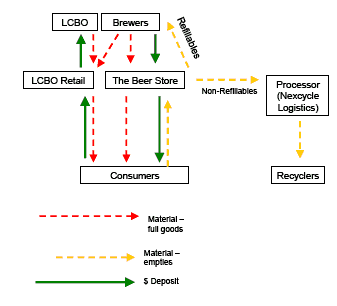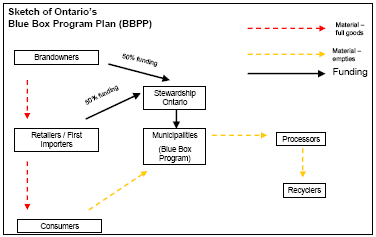| Name | Ontario Deposit Return Program (under the Liquor Control Act); colloquially known as Bag It Back | ||||||||||||||||||||||||||||||
| Date Enacted | 2006 | ||||||||||||||||||||||||||||||
| Date Implemented | 2/5/2007 | ||||||||||||||||||||||||||||||
| Containers Covered |
Plastics (PET), metal (aluminum/tinplate), bimetal, glass, gable top, Tetra Pak, bag-in-box containers [1] |
||||||||||||||||||||||||||||||
| Beverages Covered | All alcoholic beverages (including wines, beers, and spirits) | ||||||||||||||||||||||||||||||
| Beverages Not Covered |
|
||||||||||||||||||||||||||||||
| Amount of Deposit | Glass bottles, plastic bottles (PET), Tetra Pak containers, bag-in-box: ≤ 630mL: 10¢ > 630 mL: 20¢ Aluminum and steel containers ≤ 1L: 10¢ > 1L: 20¢ |
||||||||||||||||||||||||||||||
| Reclamation System | Return to The Beer Store (TBS), bulk return locations, or contracted empty bottle dealers (LCBO does not accept containers) | ||||||||||||||||||||||||||||||
| Handling Fee | Proprietary | ||||||||||||||||||||||||||||||
| Other Fees | LCBO pays a per unit service fee to TBS for every bottle returned that was not originally sold by TBS. This fee is currently 10.18¢ as of 2018. [2] | ||||||||||||||||||||||||||||||
| Unredeemed Deposits | Retained by beer distributor/ bottler. | ||||||||||||||||||||||||||||||
| Program Success |
Redemption rates:
TBS Refillables Redemption Rate (2019-2020):
|
||||||||||||||||||||||||||||||
| Complementary Recycling Programs |
95% of households have access to curbside and depot recycling, as part of Ontario's Blue Box Program. |
Details
Ontario relies on a joint municipal and industry-funded curbside recycling system for all residential beverage containers. Alcohol beverage containers (e.g. for wine, beer and spirits) can also be returned for reuse/recycling through a deposit-return system.
The Beer Store, the primary distributor for beer in the province, has operated a deposit-return system on its containers since 1927 [5], but on February 5, 2007, Ontario government began collecting and refunding deposits on all beverage alcohol containers, not just beer. All container deposits are fully refundable.
Alcoholic Beverage System
The Beer Store
Beer is sold out of two major channels, the Beer Store (TBS), run by brewers, and the Liquor Control Board of Ontario, (LCBO) run by the government, which sells other alcoholic beverages and imported beers. In addition, in some rural areas, alcohol is sold through LCBO Combination Stores and privately owned Agency Stores. Combination stores are owned by the LCBO but have a more even split between wine/spirits and beer on their shelves. Agency stores are licensed to distribute alcohol in remote communities where a full Beer Store is not justified. Domestic and imported beer is sold through all locations, but not all imported beer is returnable for a refund.
Refillable containers comprise roughly 85% of the total beer containers sold in Ontario, with an average reuse lifespan of 15 times. [6] 97% of all refillable beer containers are returned. All costs, such as handling and transportation, are internalized through the Beer Store system. The Beer Store contracts roughly 150 authorized empty bottle dealers to collect used containers in rural markets serviced by LCBO Combination and Agency stores.
The Beer Store requires its brewers to pay it a handling fee that is not publicly available. Industry-standard refillable bottles have the lowest fee, while non-standard and non-refillable bottles have higher fees. [7]
Other alcoholic beverages
In 2007, the Liquor Control Board of Ontario instituted its Deposit Return program, also known as "Bag It Back," and began collecting 10-cent and 20-cent deposits on all alcoholic beverage containers, including those sold through avenues other than The Beer Store. Regardless of where they were purchased, these containers must be returned to The Beer Store for a refund.

Graphic displaying the flow of containers and money in the Ontario Deposit-Return system
Image source: R3 Consulting Group and Clarissa Morawski. "Section 7. Ontario" Figure 1. Evaluating End-of-Life Beverage Container Management Systems for California. 2009.
Non-Alcoholic System
Name of program: Blue Box Program
Collection success: 60.2% [8]
Details
Ontario's municipal Blue Box programs (and other producer responsibility programs in the province) are overseen by the Resource Productivity and Recovery Authority (RPRA), a nonprofit organization created to administer Ontario's circular economy laws.
In the mid to late 1970s, the soft drink industry began a strategy of consolidating its bottling production to reduce costs. The industry also began to increase the number of cans and PET plastic containers in the market. In the early 1980s, refillable glass had dropped steadily as a percentage of beverage sales and efforts were made by the government to preserve refillables. The soft drink industry was able to negotiate a reduction in what was a formal refillable quota from 75% to 30% by agreeing to contribute $20 million over five years to expand the Blue Box system.
Under that version of Ontario's Blue Box Program, companies that introduce packaging and printed paper into Ontario’s consumer marketplace ("Stewards") were to pay for 50% of the funding of Ontario's municipal Blue Box programs.
To help them meet this obligation at the lowest possible cost, Stewardship Ontario, the Industry Funding Organization that operates the Blue Box Program (as well as the Orange Drop Program for hazardous or special waste) was founded. Stewardship Ontario collects the funds required of Blue Box stewards (brand owners and/or first importers), and distributes them to municipalities.

Flowchart showing how Ontario's Blue Box program works and how it is funded.
Image source: R3 Consulting Group and Clarissa Morawski. "Section 8. Ontario" Figure 8-1. Evaluating End-of-Life Beverage Container Management Systems for California. 2009.
On November 30, 2016, the Ontario Government proclaimed the Resource Recovery and Circular Economy Act (RRCEA) and the Waste Diversion Transition Act (WDTA), both of which were enacted by the 2016 Waste-Free Ontario Act
The 2016 Resource Recovery and Circular Economy Act establishes an outcome-based producer responsibility regime that holds producers accountable for recovering resources and reducing waste associated with their products and packaging. Producers and anyone else involved with reducing, reusing and recycling waste will need to register, report, meet regulated requirements and promote and encourage public participation in recycling activities.
The 2016 Waste Diversion Transition Act provides for the transition of the four existing waste diversion programs (Blue Box, Used Tires, Waste Electrical and Electronic Equipment, Municipal Hazardous or Special Waste) and it facilitates the wind-up of Industry Funding Organizations operating those programs. It replaces the 2002 Waste Diversion Act, granting new powers to the then-newly created Resource Productivity and Recovery Authority to oversee and enforce the transition of these programs, and permits an increase in funding to municipalities for the operation of the Blue Box Waste Diversion Program from 50%.
Since 2008, the Blue Box Program has an overall provincial 60% collection target, and has stalled around this rate since. [9]
Consequently, in October 2020 the Ontario Ministry of the Environment announced they were moving forward with a newly proposed Blue Box transition plan to shift the program to a 100% producer responsibility framework in an effort to reduce municipal cost burden and to also increase overall collection rates. [10] Currently, producers pay for half of the program's costs. The transition aimed to:
- Standardize and increase the list of materials accepted in the program.
- Transition the costs of the program away from municipal taxpayers to product and packaging producers.
- Expand blue box services to more communities, such as smaller, rural and remote communities, including those under 5,000 people.
- Set the highest diversion targets in North America for every waste category.
- Expand current Blue Box services to apartment buildings, schools, long-term care homes, and parks.
Public comment on the draft legislation for the program closed December 3, 2020. [11] RPRA approved of the draft legislation plan on December 23, with conditions regarding 2021's steward fee schedule, along with increased transparency from Stewardship Ontario. Stewardship Ontario hopes to implement their material cost methodology in 2022, in consideration of RPRA's conditions. [12]
According to their Annual Report, "In July 2021, the Ontario government passed a new Blue Box Regulation which defines beverage containers as its own category and sets a target of 75% recovery by 2026 and 80% by 2030. All beverage producers are financially and operationally responsible for the collection and management of Blue Box materials supplied to consumers as of July 1, 2023. To reach these targets, beverage containers consumed both at home and away from home (approximately 30% of the total beverage container generation) will need to be recovered.". [13] Beginning in July 2023, some communities will begin receiving Blue Box services financed and operated by producers under RRCEA and Blue Box Regulation. All of Ontario communities will be covered by December 2025. [14]
Other Fees: Previously under the Blue Box Program, companies that introduce packaging and printed paper into Ontario’s consumer marketplace share in paying 50% of the funding of Ontario's municipal Blue Box programs through Stewardship Ontario. Now under RPRA, producers are 100% responsible for funding the programs. Specific producer fees will be variable and further details can be found on their website here.
Footnotes
[1] "Eligible Items and Return Rates." Bag it Back Ontario, last accessed January 2021.
[2] "Global Deposit Book 2020: An Overview of Deposit Systems for One-Way Beverage Containers." Reloop Inc. December 15, 2020.
[3] "Global Deposit Book 2022: An Overview of Deposit Systems for Single-Use Beverage Containers." Reloop Inc. 2022.
[4] "Reuse & Recycle to Build a Cleaner, Greener Ontario: The Beer Store Responsible Stewardship 2018." Brewers Retail Inc. March 2019.
[5] "Evaluating End-of-Life Beverage Container Management Systems for California." Morawski, Clarissa. R3 Consulting Group. May 15, 2009.
[6] "ADVANCING THE CIRCULAR ECONOMY, ONE CONTAINER AT A TIME. THE BEER STORE RESPONSIBLE STEWARDSHIP 2016." The Beer Store. 2017.
[7] "Evaluating End-of-Life," Morawski, Clarissa. (see footnote 4.)
[8] "ANNUAL REPORT 2019." Resource Productivity & Recovery Authority (RPRA). 2020.
[9] "The Blue Box Program Plan." Stewardship Ontario, last accessed January 2021.
[10] "Ontario Developing a Stronger, More Effective Blue Box Program." Queen's Printer for Ontario. October 19, 2020.
[11] "A proposed regulation, and proposed regulatory amendments, to make producers responsible for operating blue box programs." Ministry of the Environment, Conservation and Parks. Closed December 3, 2020.
[12] "RPRA Approves Transition Plan with Conditions that Impact Steward Fees." Stewardship Ontario, December 23, 2020.
[13] "Annual Report 2021." Canadian Beverage Container Recycling Association. Last Acessed September 13, 2023.
[14] "Blue Box Transition: Transition Timeline." Stewardship Ontario. 2021.
Last Updated on September 13, 2023.